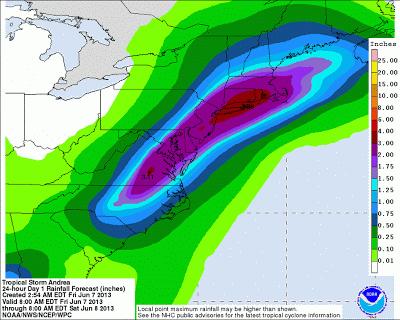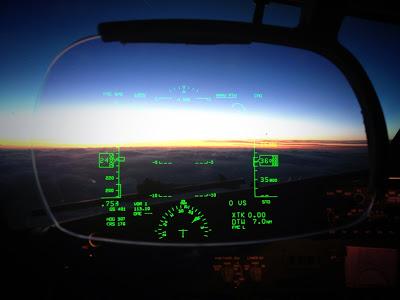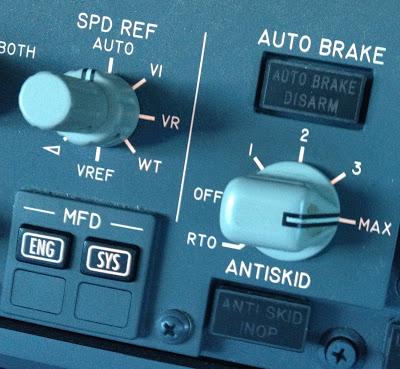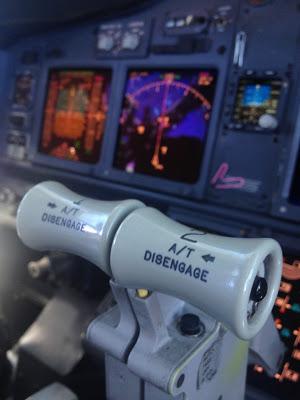
Since I went through 737 training with another first officer, I occupied the captain's seat when it was my partner's turn to fly and had the opportunity to utilize the HUD on a number of occasions. I found it to be especially useful, but also slightly distracting during the approach and landing phase of the flight. At my airline, when the HUD is operable, it is required to be used for all takeoffs and landings and I’m told many captains become what are affectionately referred to as “HUD babies” as they become increasingly dependent on the technology. I mention this only because I noticed, even in the simulator when there was very little in the way of visual distraction, that focusing on the information displayed on the HUD was often difficult with rain and clouds whipping through the landing lights.

Looking through the HUD in favorable weather conditions.
As the glide slope came alive, I tweaked the radar beam slightly and commented on a band of heavy rain just south of the approach end of runway 4. We were already flying through what I would call moderate rain and I expected the intensity to increase significantly about the time we reached minimums. It’s at that point...on an approach...in the weather...cloud bases and visibility near the legal minimums and approaching the decision point...that I've found to be one of the most challenging parts of my job. In a two man cockpit, one pilot is intently focused on the instruments as the aircraft descends to about 200 feet above the ground while the other pilot splits his attention between his responsibilities to both monitor the progress of the approach and identify visual cues like the approach lighting system or the runway as it emerges through the clouds. If the approach lights come into view by 200 feet, the monitoring pilot will announce "continue" and the flying pilot will stay on instruments and descend to 100 feet above the runway. If they’re lucky, they'll descend through the bases of the clouds or out of the rain before reaching minimums and the pilot flying the airplane will have a mere 100 feet to transition from inside the cockpit to the runway environment, flare, compensate for the crosswind and land.For most pilots, it's a rare flight that terminates like that, with everything coming together at once, but when it does it’s one of the most challenging things we do.

Auto Brake set to MAX in anticipation of standing water on a short runway.
As we passed through 1,000 feet, the rain seemed to let up slightly and I was able make visual contact with the ground as Queens, New York passed beneath our wings. We descended another five hundred feet before the rain began to intensify once again and visual contact was lost. At that point I was spending at least as much time looking out the forward window as I was crosschecking the instruments, but the captain remained fixated on the HUD. I remembered my experience with the HUD and wondered if the captain was having trouble focusing. I almost thought out loud, “this one is going to be close.”We descended another 100 feet and the noise level in the cockpit increased significantly as the rain continued to intensify. I had the wipers set to high but they were proving to be useless...effective noise makers, but little else. Another 100 feet slipped by and an automated voiced announced "minimums." I could see the faint blur of the ground through what seemed like a river of water on the windshield, but I saw no evidence of the approach lighting system much less the runway. "Go around!"
I mentioned before how difficult it can be to make the transition from instruments to a visual landing when the weather is near minimums, but the stress felt by the pilot in that situation is almost always replaced with the reward and satisfaction of a successful landing. Every now and then, as with this approach, the successful termination of the approach is a go around.
It might seem strange to hear me use the word "successful" when describing a go around. After all, the whole point an approach is to land, but my airline touts a no fault go around policy designed to remove any pressure to land in unsafe conditions. Regardless of the reason...visibility, runway condition, crosswind limits, etc., if one of our pilots elects to go around, that decision will never be questioned. So while it isn't the desired outcome, a go around is considered a successful termination of the approach.
The go around is another thing I have learned to love about the 737. As an MD80 pilot, a go around was an exceptionally busy procedure. The standard litany went something like this: "Go around, flaps 15, positive rate, gear up, set missed approach altitude, heading hold, NAV." The flight director would command the pitch attitude, the auto throttles would automatically advance the engines to full go around thrust and the airplane would point to the moon with an initial climb rate often enough to max out the vertical speed indicator. The pilot still had to reduce the rate of climb passing 1,000 feet, retract flaps and level off at the missed approach altitude…all while navigating the required ground track.
Since we rarely perform the procedure and they often occur without warning, a go around almost always makes for a busy cockpit.
The procedure is slightly more simple on the 737. A single push of the TOGA button (Take Off/ Go Around) results in the flight director commanding the necessary pitch attitude to climb and an increase in thrust on the engines just enough to attain an easy to manage 1,000 foot per minute climb. If desired, a second push of the TOGA button results in a full power go around. The airplane also has an “auto bug up” feature that automatically displays the speed at which flaps should be retracted and automatically engages GPS navigation. The pilot is still responsible for raising the gear and flaps on schedule, but just about everything else happens on its own.

Usually pressed with the pilot's index finger, the black button below the throttle handle engages TOGA.
With nothing to see out the windows but water, the captain responded to the go around call and even with all the traffic in the area, we were tracking the localizer for another attempt within ten minutes. Pilots don’t like to go around. Regardless of policy removing any blame from the cockpit, a go around usually feels like a failure. The airplane in front of us managed to land and the one behind us got in as well. It all came down to timing with respect to a thin line of heavy rain. Our timing was bad, but the end result was the safe operation of our flight...and no one questioned the decision to go around.Thanks to the tailwind we enjoyed on our west to east flight, we were at the gate running the Parking Checklist fifteen minutes before scheduled arrival.
